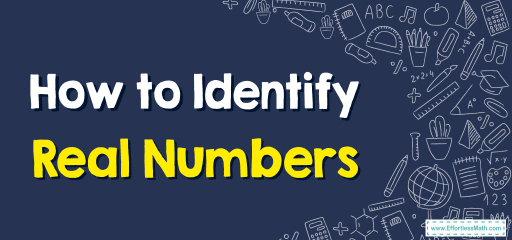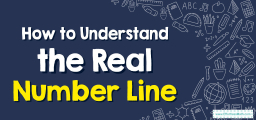How to Identify Real Numbers
Begin with an appreciation for the vast universe of numbers. Like stars in the night sky, numbers are infinite and diverse, each with unique properties and significance. Within this universe, there's a constellation known as 'Real Numbers'.

Step-by-step Guide to Identify Real Numbers
Here is a step-by-step guide to identifying real numbers:
Step 1: Basic Number Categories
- Natural Numbers (N): Think of these as the earliest numbers humans understood—those used for counting: \(1, 2, 3\), and so on. Zero isn’t included here.
- Whole Numbers (W): Natural numbers accompanied by the \(0\). Thus, \(0, 1, 2, 3\), etc.
- Integers (Z): Here’s where the spectrum expands to negative numbers: \(…,-3, -2, -1, 0, 1, 2, 3,…\)
Step 2: Venturing into the Fractional Realm
- Rational Numbers (Q): Imagine numbers that can be expressed as a fraction where both the numerator and the denominator are integers (the denominator is not zero). This category includes both negative and positive fractions, like \(\frac{1}{2}, \frac{-3}{4}\), and even integers because, say, \(5\) can be expressed as \(\frac{5}{1}\).
Step 3: Exploring the Abyss of the Irrational
- Irrational Numbers: These are the mysterious ones! They cannot be expressed as fractions like the rationals. Instead, their decimal representations go on forever without repeating. Examples? The square root of any prime number or the famous number \(π\) (Pi).
Step 4: The Grand Ensemble: Real Numbers (R)
Merge the rational and irrational numbers! You’ve got the set of real numbers. Whether it’s a neat fraction, a terminating or repeating decimal, or a never-ending non-repeating decimal— they all belong to this grand set.
Step 5: Visualizing with The Number Line
Picture a straight, infinite line. This is the number line. Every point on this line corresponds to a real number. The integers are marked at equidistant points. Between any two integers, there are an infinite number of both rational and irrational numbers.
Step 6: Identifying Real Numbers- Key Traits
- Definite Position: Every real number has a specific location on the number line.
- Completeness: For any two different real numbers, one is always greater than, less than, or equal to the other.
- Decimal Representation: Whether it ends (like \(0.5\)), repeats (like \(\frac{1}{3} = 0.333…\)), or neither ends nor repeats (like \(π\)), each real number has a decimal representation.
Step 7: Distinguishing Non-Real Numbers
For identification purposes, it’s essential to also know what real numbers aren’t. For instance, the square root of \(-1\) doesn’t fit within the real number spectrum. Such numbers are termed imaginary and, combined with real numbers, form the complex numbers.
Step 8: Delving Deeper with Algebra
Algebraic structures, like fields, further expand upon the properties of real numbers. These structures provide rules for addition, subtraction, multiplication, and division, reinforcing the richness of the real number set.
Step 9: Reflect and Engage
Understanding real numbers is foundational in mathematics. Engage with puzzles, exercises, or even real-world applications to solidify your comprehension. From measuring distances to calculating financial interests, real numbers are everywhere!
Remember, like navigating any vast landscape, understanding the real numbers is a journey. With curiosity as your compass, you’re well on your way to mathematical enlightenment.
Examples:
Example 1:
Is \(\sqrt{−1}\) a real number?
Solution:
No, \(\sqrt{−1}\) is not a real number. It’s an imaginary number, often represented as \(i\).
Example 2:
Is \(-17\) a real number?
Solution:
Yes, \(-17\) is an integer, and since every integer is a real number, \(-17\) is a real number.
Related to This Article
More math articles
- FREE 7th Grade MEAP Math Practice Test
- How to Match Word Problems with the One-Step Equations?
- The Best Teacher Desks in 2024
- How to Prepare for the TABE Math Test?
- How to Decode Decimals: Unveiling the Value of Each Digit
- Full-Length 7th Grade PSSA Math Practice Test-Answers and Explanations
- How Is the ALEKS Test Scored?
- How to Prepare for the HSPT Math Test?
- Using Number Line to Graph Percentages
- 4th Grade Wisconsin Forward Math Worksheets: FREE & Printable


















What people say about "How to Identify Real Numbers - Effortless Math: We Help Students Learn to LOVE Mathematics"?
No one replied yet.